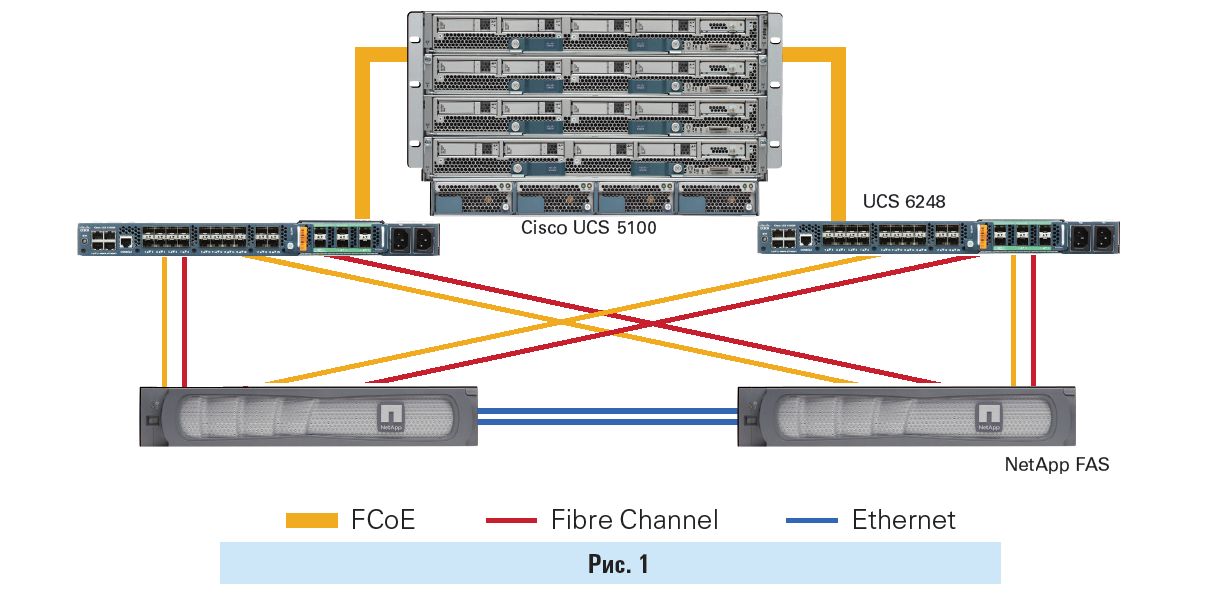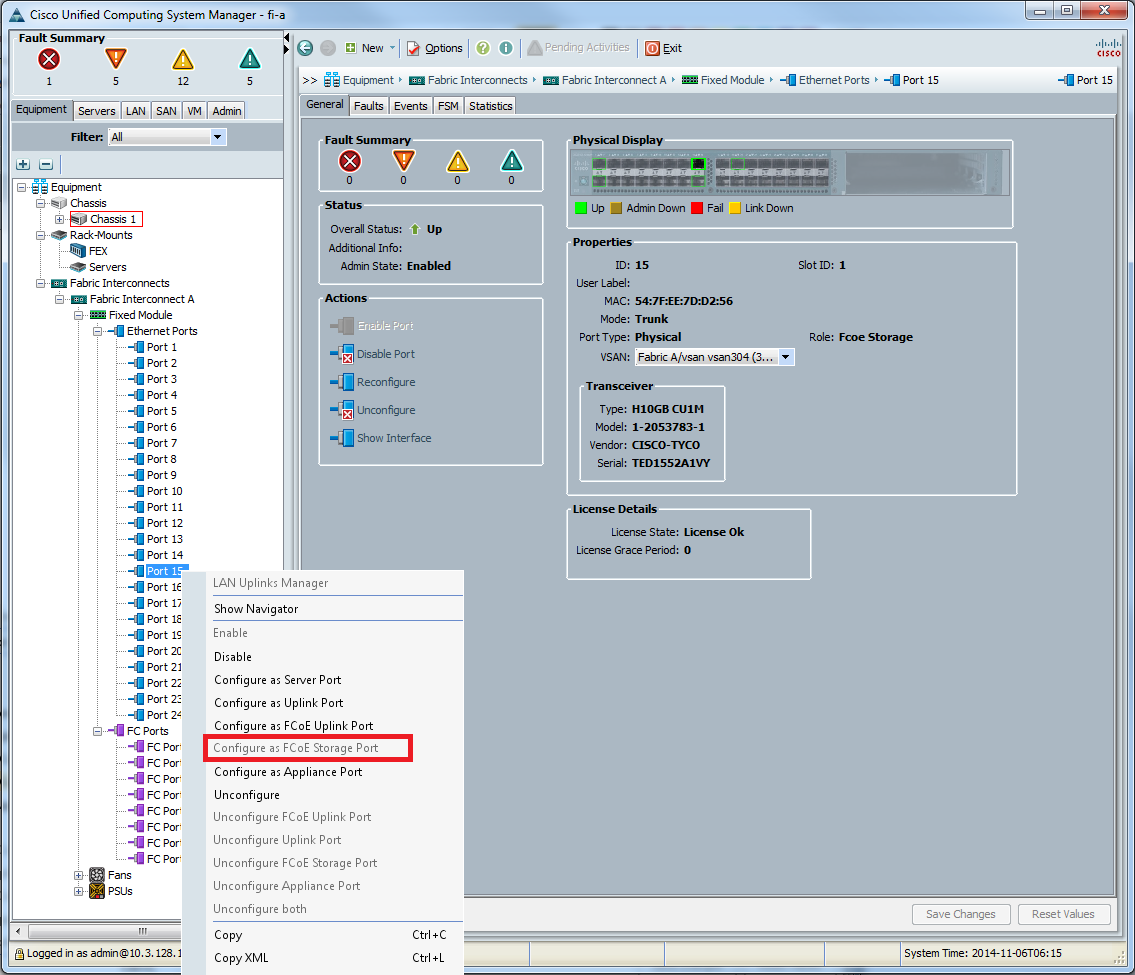non-FlexPod DC: Direct-Attached Storage, One-stop support
In one of my articles I explained what the FlexPod DC architecture is and what it consists of, the physical components of the FlexPod DC include: NetApp FAS series storage systems, Cisco UCS server and Nexus switches. There is a wide variety of supported FlexPod DC designs consisting of these three main components. In order to take advantage of co-operative support from one source, an appropriate support service is needed for all these components.
What if you have Cisco SnartNet and NetApp Support Edge services, and there are no Nexus switches in the architecture, while storage is directly included in UCS Fabric Interconnect?
This is the “non-FlexPod DC” architecture that will be discussed; it can also be supported from a “single source” by the Cisco Solution Support for Critical Infrastructure (SSCI) program.
')

The overall design of the SAN network with direct connection
To use the FC protocol on FI devices, you will need to enable FC Switching mode and FC zoning function, the ports connected to the storage system will need to be switched to the Storage Port mode and create a VSAN (not to be confused with VMware vSAN) in the Storage Cloud section:
For FI, it is now possible to receive simultaneously “regular” Ethernet traffic (for example, CIFS , iSCSI , NFS ) and FCoE over the same port. If your storage has CNA or UTA2 ports (all FAS 255x and FAS 8000 series are on board) and supports, as well as FI , the ability to run Ethernet and FCoE through a single link (all NetApp FAS with CNA / UTA2 support), you can switch the ports such devices directly, without a switch.
The downside of the direct-on configuration is poor scalability and the ability to configure fault tolerance and load balancing across network links for all types of network traffic.
For Ethernet traffic both in conjunction with direct power and iSCSI protocol, direct power and FCoE protocol, as well as for the FC protocol with direct connection , load balancing on network links and fault tolerance is achieved by using multi-paging built into these protocols.
In the design of the FlexPod DataCenter, the Nexus series switches are still an essential component of the architecture:
I ask to send messages on errors in the text to the LAN .
Comments, additions and questions on the article on the contrary, please in the comments .
What if you have Cisco SnartNet and NetApp Support Edge services, and there are no Nexus switches in the architecture, while storage is directly included in UCS Fabric Interconnect?
This is the “non-FlexPod DC” architecture that will be discussed; it can also be supported from a “single source” by the Cisco Solution Support for Critical Infrastructure (SSCI) program.
')

The overall design of the SAN network with direct connection
To use the FC protocol on FI devices, you will need to enable FC Switching mode and FC zoning function, the ports connected to the storage system will need to be switched to the Storage Port mode and create a VSAN (not to be confused with VMware vSAN) in the Storage Cloud section:
Configure as FC Storage Port

Configure as FCoE Storage Port

For FI, it is now possible to receive simultaneously “regular” Ethernet traffic (for example, CIFS , iSCSI , NFS ) and FCoE over the same port. If your storage has CNA or UTA2 ports (all FAS 255x and FAS 8000 series are on board) and supports, as well as FI , the ability to run Ethernet and FCoE through a single link (all NetApp FAS with CNA / UTA2 support), you can switch the ports such devices directly, without a switch.
Configuring Unified Ports
From the NetApp storage side, you need to switch the ports to the CNA state (you need to have CNA ports, regular Ethernet 1 / 10Gbs ports do not support this), using the ucadmin command on the storage system (you will need to restart the storage system ). The system will display independently “virtual” Ethernet ports and “virtual” FC ports, separately (although the physical port will be used for one such “virtual” Ethernet and one “virtual” FC ). These ports are configured separately, like normal physical ports.
On FI, you need to enable the FC mode in the “Switching mode” state, in the Fabric A / B settings on the “Equipment” tab. This setting will require a restart of FI .
After restarting FI on the Equipment tab, converged ports will need to be switched to Appliance port mode, after a few seconds the port will go online. Then reconfigure the port in the “FCoE Storage Port” mode, in the right pane you will see the port type “ Unified Storage ”. Now it will be possible to choose VSAN and VLAN for such a port. And an important point, created earlier by VSAN , must have included “FC zoning” on FI in order to perform zoning.
- First, you need a firmware version not lower than Cisco UCS firmware 2.1
- Secondly, you need storage with 10GB CNA ports
From the NetApp storage side, you need to switch the ports to the CNA state (you need to have CNA ports, regular Ethernet 1 / 10Gbs ports do not support this), using the ucadmin command on the storage system (you will need to restart the storage system ). The system will display independently “virtual” Ethernet ports and “virtual” FC ports, separately (although the physical port will be used for one such “virtual” Ethernet and one “virtual” FC ). These ports are configured separately, like normal physical ports.
On FI, you need to enable the FC mode in the “Switching mode” state, in the Fabric A / B settings on the “Equipment” tab. This setting will require a restart of FI .
After restarting FI on the Equipment tab, converged ports will need to be switched to Appliance port mode, after a few seconds the port will go online. Then reconfigure the port in the “FCoE Storage Port” mode, in the right pane you will see the port type “ Unified Storage ”. Now it will be possible to choose VSAN and VLAN for such a port. And an important point, created earlier by VSAN , must have included “FC zoning” on FI in order to perform zoning.
The downside of the direct-on configuration is poor scalability and the ability to configure fault tolerance and load balancing across network links for all types of network traffic.
For Ethernet traffic both in conjunction with direct power and iSCSI protocol, direct power and FCoE protocol, as well as for the FC protocol with direct connection , load balancing on network links and fault tolerance is achieved by using multi-paging built into these protocols.
In the design of the FlexPod DataCenter, the Nexus series switches are still an essential component of the architecture:
- firstly, because FlexPod must somehow be integrated into the existing infrastructure and provide access to clients
- secondly, switching on Nexus switches will allow the architecture to scale in the future
- thirdly, in contrast to the direct connection with the SAN ( FC / FCoE / iSCSI ), the Ethernet network design for the NAS requires an intermediate link between the storage system and the UCS domain to perform load balancing on the network links, and mainly fault tolerance functions.
- fourth, external client access via Ethernet to the FlexPod should be fault tolerant
- Benefits of FlexPod configurations
I ask to send messages on errors in the text to the LAN .
Comments, additions and questions on the article on the contrary, please in the comments .
Source: https://habr.com/ru/post/244623/
All Articles